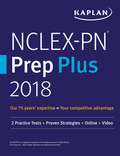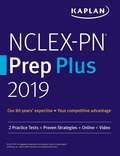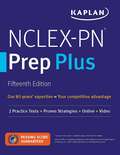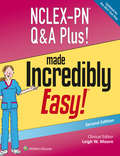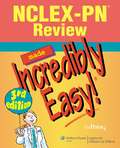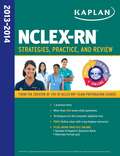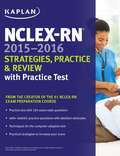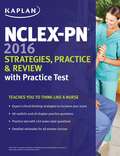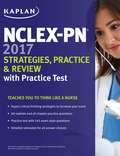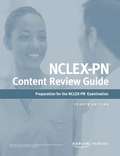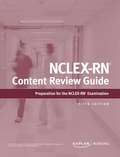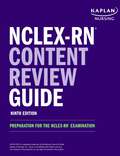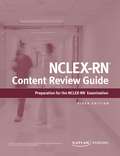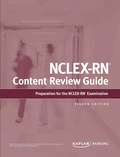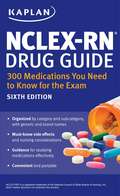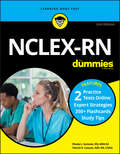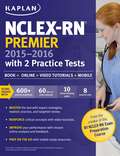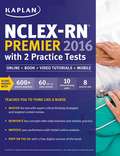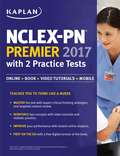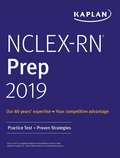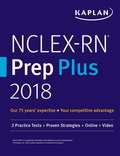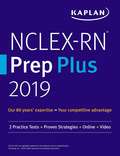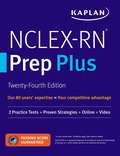- Table View
- List View
NCLEX-PN Prep Plus 2018: 2 Practice Tests + Proven Strategies + Online + Video
by Kaplan NursingA Simon & Schuster eBook. Simon & Schuster has a great book for every reader.
NCLEX-PN Prep Plus 2019: 2 Practice Tests + Proven Strategies + Online + Video (Kaplan Test Prep)
by Kaplan NursingThe NCLEX-PN exam is not just about what you know—it's about how you think. Kaplan's NCLEX-PN Prep Plus 2019 uses expert critical thinking strategies and targeted sample questions to help you put your expertise into practice and ace the exam!The NCLEX-PN exam tests how you'll apply the medical knowledge you've gained in real-life situations. In NCLEX-PN Prep Plus 2019, Kaplan's all-star nursing faculty teaches you 9 critical thinking pathways to help you break down what exam questions are asking. Six chapters end with practice sets to help you put these critical thinking principles into action.Get everything in NCLEX-PN Prep 2019, plus one more practice test online, additional practice questions, 60 minutes of video tutorials, and a digital copy of the book.With NCLEX-PN Prep Plus 2019 you can study on-the-go. Log in from anywhere to watch video tutorials, review strategies, and take your online practice test.Proven Strategies. Realistic Practice.9 critical thinking pathways to break down what exam questions are asking6 end-of-chapter practice sets to help you put critical thinking principles into action2 full-length practice tests to gauge your progress—one in the book, one onlineDetailed rationales for all answer choices, correct and incorrectTechniques for mastering the computer adaptive test formatExpert GuidanceIn-depth content review, organized along the exam's "Client Needs" framework60 minutes of video tutorials on the ins and outs of the NCLEX-PNKaplan's Learning Engineers and expert psychometricians ensure our practice questions and study materials are true to the testWe invented test prep—Kaplan (www.kaptest.com) has been helping students for 80 years, and our proven strategies have helped legions of students achieve their dreams
NCLEX-PN Prep Plus: 2 Practice Tests + Proven Strategies + Online + Video (Kaplan Test Prep)
by Kaplan NursingThe NCLEX-PN exam is not just about what you know—it's about how you think. Kaplan's NCLEX-PN Prep Plus uses expert critical thinking strategies and targeted sample questions to help you put your expertise into practice, apply the knowledge you&’ve gained in real-life situations, and face the exam with confidence.In NCLEX-PN Prep Plus, Kaplan's all-star nursing faculty teaches you essential strategies and critical-thinking techniques you need to apply your knowledge.Proven Strategies. Realistic Practice.9 critical thinking pathways to break down what exam questions are asking6 end-of-chapter practice sets to help you put critical thinking principles into action2 full-length practice tests to gauge your progress—one in the book, one onlineDetailed rationales for all answer choices, correct and incorrectTechniques for mastering the computer adaptive test formatExpert GuidanceIn-depth content review, organized along the exam's "Client Needs" framework60 minutes of video tutorials on the ins and outs of the NCLEX-PNKaplan's learning engineers and expert psychometricians ensure our practice questions and study materials are true to the testWe invented test prep—Kaplan (www.kaptest.com) has been helping students for 80 years, and our proven strategies have helped legions of students achieve their dreamsWith NCLEX-PN Prep Plus you can study on-the-go. Log in from anywhere to watch video tutorials, review strategies, and take your online practice test.
NCLEX-PN Q&A Plus! Made Incredibly Easy! (Incredibly Easy! Series® Ser.)
by Leigh W. MooreNCLEX-PN Q&A Plus! Made Incredibly Easy, 2E is designed to help pre-licensure nursing students in practical and vocational nursing programs prepare to take the licensing examination. The book is divided into seven parts: basics of the NCLEX, medical-surgical nursing, psychiatric/mental health nursing, maternity nursing, pediatric nursing, coordinated care, and comprehensive tests. More than 4,000 questions throughout prompt active learning and higher-order thinking, align with the National Council of State Boards of Nursing (NCSBN) 2017 PN test plan, and are written in the style used on the licensing examination. Other features include the use of all alternate-format questions found on the licensing examination and detailed rationale for both correct and incorrect answers.
NCLEX-PN Review Made Incredibly Easy! (3rd Edition)
by Springhouse Publishing Company StaffNCLEX-PN® Review Made Incredibly Easy! Third Edition is an easy-to-read, outline-format NCLEX® preparation book with online questions and answers. The book uses the well-known light-hearted Incredibly Easy! approach to make NCLEX® review more interesting, enjoyable, and concise and to encourage knowledge retention by decreasing study anxiety. The book covers every area of nursing and every test, disorder, and procedure that LPNs/LVNs need to know for the NCLEX®, including adult care, psychiatric care, maternal-neonatal care, care of the child, coordinating care, drug administration, patient positioning, and care and monitoring of nasogastric, chest, and other body tubes. Critical thinking questions accompany each chapter. This edition has been updated to reflect the latest NCLEX-PN® test plan, including new alternate-format types of questions, and includes updated nursing diagnoses that reflect the latest NANDA taxonomy. The companion Website offers more than 1,000 additional NCLEX®-style practice questions, including alternate format questions, with rationales for correct and incorrect answers. Other online resources include a study tip sheet; a tutorial on NCLEX® question types and test-taking; and printable cheat sheets.
NCLEX-RN 2013-2014
by KaplanTo become a registered nurse in the United States, nursing school graduates must pass the National Council Licensure Examination for Registered Nurses (NCLEX-RN). It is a computer-adaptive test with between 75 and 265 questions that can take up to 6 hours. Each year, around 200,000 nursing students take this exam. Strategies play an important role in passing the NCLEX-RN, which is a critical thinking test requiring students to go beyond simply recognizing facts. In this guide, test-takers will have access to the most effective methods available to guarantee a passing score. Kaplan guarantees that readers will pass using our guide. Kaplan NCLEX-RN is the only book to combine its unique strategy guide with a comprehensive review designed to meet the challenges of this rigorous exam, including: * 2 practice tests (one in the book and the second both on the CD-ROM and online) detailed answer explanations * In-depth analysis of NCLEX-RN question types * Review of alternate question types * 47-item sample of Kaplan's rigorous NCLEX-RN Question Bank online With more of the most challenging questions and a bold, user-friendly design, Kaplan NCLEX-RN will make readers assured and confident on test day.
NCLEX-RN 2015-2016 Strategies, Practice, and Review with Practice Test
by KaplanPass the NCLEX-RN! NCLEX-RN 2015-2016 Strategies, Practice, and Review with Practice Test combines Kaplan's unique strategy guide with the most test-like questions available to help you to meet the challenges of this rigorous exam, including: * Full-length practice test* Chapter-end practice sets* In-depth analysis of NCLEX-RN question types* Review of exam content and structure* Review of alternate question types* Detailed answer explanationsWith challenging practice questions and a bold, user-friendly design, Kaplan's NCLEX-RN 2015-2016 Strategies, Practice, and Review with Practice Test will make you assured and confident on test day.
NCLEX-RN 2016 Strategies, Practice and Review with Practice Test
by KaplanPass the NCLEX-RN! Passing the NCLEX-RN exam is not just about what you know--it's about how you think. With expert critical thinking strategies and targeted practice, Kaplan's NCLEX-RN 2016 Strategies, Practice & Review with Practice Test shows you how to leverage your content knowledge to think like a nurse.Features: * 10 critical thinking paths to break down what exam questions are asking* 8 end-of-chapter practice sets to help you put critical thinking principles into action* Streamlined content review, organized along the exam's "Client Needs" framework* Review of all question types, including alternate-format questions* Full-length practice test* Detailed rationales for all answer choices, correct and incorrect* Techniques for mastering the computer adaptive testWith expert strategies and the most test-like questions anywhere, Kaplan's NCLEX-RN 2016 Strategies, Practice & Review with Practice Test will make you assured and confident on test day.
NCLEX-RN 2017 Strategies, Practice and Review with Practice Test
by Kaplan NursingTeaches you to think like a nurse Passing the NCLEX-RN exam is not just about what you know—it’s about how you think. With expert critical thinking strategies and targeted practice, Kaplan’s NCLEX-RN 2017 Strategies, Practice & Review shows you how to leverage your content knowledge to think like a nurse. Kaplan’s NCLEX-RN Strategies, Practice & Review includes: • 10 critical thinking paths to break down what exam questions are asking • 8 end-of-chapter practice sets to help you put critical thinking principles into action • Full-length practice test • Streamlined content review, organized along the exam’s “Client Needs” framework • Review of all question types, including alternate-format questions • Detailed rationales for all answer choices, correct and incorrect • Techniques for mastering the computer adaptive test With expert strategies and the most test-like questions anywhere, Kaplan's NCLEX-RN 2017 Strategies, Practice & Review with Practice Test will make you assured and confident on Test Day.
NCLEX-RN Content Review Guide
by KaplanGet comprehensive review of essential nursing content with Kaplan's NCLEX-RN Content Review Guide. Up-to-date. Updated annually by Kaplan's expert nursing faculty.Complete. Covers must-know nursing content required to pass the NCLEX-RN.Expert Strategies. Master critical reasoning with Kaplan's acclaimed Decision Tree.Learner-efficient. Organized in outline format with information presented in easy-access tables.Trusted. Used by thousands of students each year to succeed on the NCLEX-RN the first time. Chapters follow the NCLEX's Client Needs Categories so you know you have complete content coverage.
NCLEX-RN Content Review Guide
by Kaplan NursingGet comprehensive review of essential nursing content with Kaplan's NCLEX-RN Content Review guide. Up-to-date. Updated annually by Kaplan’s expert nursing faculty. Complete. Covers must-know nursing content required to pass the NCLEX-RN. Expert Strategies. Master critical reasoning with Kaplan's acclaimed Decision Tree. Learner-efficient. Organized in outline format with information presented in easy-access tables. Trusted. Used by thousands of students each year to succeed on the NCLEX-RN the first time. Chapters follow the NCLEX's Client Needs Categories so you know you have complete content coverage. Kaplan regularly reviews and revises content to ensure that we are providing the most up-to-date prep, realistic practice materials, and the most current test information.
NCLEX-RN Content Review Guide (Kaplan Test Prep)
by Kaplan NursingKaplan&’s NCLEX-RN Content Review Guide provides comprehensive review of the essential content you need to ace the NCLEX-RN exam.The Best ReviewCovers all the must-know content required to pass the NCLEX-RNContent is organized in outline format and easy-access tables for efficient reviewChapters follow the NCLEX&’s Client Need Categories so you know you have complete content coverageKaplan&’s acclaimed Decision Tree and expert strategies help you master critical reasoningUsed by thousands of students each year to succeed on the NCLEX-RNExpert GuidanceKaplan&’s expert nursing faculty reviews and updates content annuallyWe invented test prep—Kaplan (www.kaptest.com) has been helping students for 80 years, and our proven strategies have helped legions of students achieve their dreams
NCLEX-RN Content Review Guide: Preparation For The Nclex-rn Examination (Kaplan Test Prep Ser.)
by Kaplan NursingA Simon & Schuster eBook. Simon & Schuster has a great book for every reader.
NCLEX-RN Content Review Guide: Preparation For The Nclex-rn Examination (Kaplan Test Prep)
by Kaplan NursingKaplan’s NCLEX-RN Content Review Guide provides comprehensive review of the essential content you need to ace the NCLEX-RN exam.The Best ReviewCovers all the must-know content required to pass the NCLEX-RNContent is organized in outline format and easy-access tables for efficient reviewChapters follow the NCLEX’s Client Need Categories so you know you have complete content coverageKaplan’s acclaimed Decision Tree and expert strategies help you master critical reasoningUsed by thousands of students each year to succeed on the NCLEX-RNExpert GuidanceKaplan’s expert nursing faculty reviews and updates content annuallyWe invented test prep—Kaplan (www.kaptest.com) has been helping students for 80 years, and our proven strategies have helped legions of students achieve their dreams
NCLEX-RN Content Review Guide: Preparation for the NCLEX-RN Examination (Kaplan Test Prep)
by Kaplan NursingKaplan&’s NCLEX-RN Content Review Guide provides comprehensive review of the essential content you need to ace the NCLEX-RN exam.The Best ReviewCovers all the must-know content required to pass the NCLEX-RNContent is organized in outline format and easy-access tables for efficient reviewChapters follow the NCLEX&’s Client Need Categories so you know you have complete content coverageKaplan&’s acclaimed Decision Tree and expert strategies help you master critical reasoningUsed by thousands of students each year to succeed on the NCLEX-RNExpert GuidanceKaplan&’s expert nursing faculty reviews and updates content annuallyWe invented test prep—Kaplan (www.kaptest.com) has been helping students for 80 years, and our proven strategies have helped legions of students achieve their dreams
NCLEX-RN Drug Guide: 300 Medications You Need to Know for the Exam
by KaplanThe most streamlined, portable, and easy-to-use drug guide to help you pass the NCLEX-RN! This pocket-sized review for prospective nurses gives you the focused, key information you need to know about medications commonly seen on the test. Kaplan's NCLEX-RN Drug Guide includes:Generic names, brand names, phonetic pronunciations, and drug families for 300 frequently tested medicationsConcise nursing considerations and must-know side effects for each medicationNEW! Expert guidance for studying drugs effectivelyPregnancy risk category and controlled substance schedule for every drugCommon medical abbreviations you'll use on the jobAbbreviations to avoid when recording medication ordersTerms are grouped by medication category, and each page features two terms with the complete explanations. With Kaplan's NCLEX-RN Drug Guide, you know you are getting the most up-to-date, expert information available to prepare for the exam!
NCLEX-RN For Dummies with Online Practice Tests
by Patrick R. Coonan Rhoda L. SommerAce the NCLEX-RN exam with this comprehensive guide The rigorous NCLEX-RN nursing exam can be painful—and many don’t pass on the initial attempt. So why not beat the odds and drastically improve your chances of acing your first time with NCLEX-RN For Dummies, 2nd Edition with Online Practice? This fully updated and revised edition is tracked to the latest NCLEX-RN exam, and comes complete with deep content review, study tips, and top test-taking strategies. You also get access to online flashcards and two practice exams with answer explanations to flesh out your technique and study. Practice with hundreds of test questions Go online for vocabulary flashcards and practice exams Find full coverage of the medical, surgical, pediatric, psychiatric, and obstetric subjects schools require for the test Written by an instructor with 38 years of hands-on nursing practice under her belt, this popular, plain-English exam prep is best-in-class and will deliver the results you want—the first time.
NCLEX-RN Premier 2015-2016 with 2 Practice Tests: Book + Online + Video Tutorials + Mobile
by KaplanPass the NCLEX-RN! NCLEX-RN Premier 2015-2016with 2 Practice Tests combines Kaplan's unique strategy guide with the most test-like questions available to help you to meet the challenges of this exacting computer-adaptive test, including: * 2 practice tests (one in the book, one online) * 60 minutes of video tutorials led by noted NCLEX expert Barbara Irwin * Mobile study resources for prep on the go * Instant online analysis and feedback on your performance * In-depth analysis of NCLEX-RN question types, including alternate format questions * 47-item sample of Kaplan's rigorous NCLEX-RN Question Bank online * Detailed answer explanations * Tips for mastering the computer-adaptive test With efficient test prep via book + online + mobile, Kaplan's NCLEX-RN Premier 2015-2016 will make you assured and confident on test day.
NCLEX-RN Premier 2016 with 2 Practice Tests: Online + Book + Video Tutorials + Mobile
by KaplanTeaches you to think like a nurse Pass the NCLEX-RN! Passing the NCLEX-RN exam is not just about what you know--it's about how you think. With expert critical thinking strategies and targeted practice, Kaplan's NCLEX-RN Premier 2016 with 2 Practice Tests shows you how to leverage your content knowledge to think like a nurse. Features:* 10 critical thinking paths to break down what exam questions are asking* 8 end-of-chapter practice sets to help you put critical thinking principles into action* 2 full-length practice tests to gauge your progress--one online, one in the book* Detailed rationales for all answer choices, correct and incorrect * 60 minutes of video tutorials* Techniques for mastering the computer adaptive test* Digital version of the book for mobile study* Streamlined content review, organized along the exam's "Client Needs" framework* Review of all question types, including alternate-format questions
NCLEX-RN Premier 2017 with 2 Practice Tests: Online + Book + Video Tutorials + Mobile
by Kaplan NursingTeaches you to think like a nurse Passing the NCLEX-RN exam is not just about what you know—it’s about how you think. With expert critical thinking strategies and targeted practice, Kaplan’s NCLEX-RN Premier 2017 shows you how to leverage your content knowledge to think like a nurse. Kaplan’s NCLEX-RN Premier includes: • 10 critical thinking paths to break down what exam questions are asking • 8 end-of-chapter practice sets to help you put critical thinking principles into action • 2 full-length practice tests to gauge your progress—one in the book, one online • 60 minutes of video tutorials • Digital version of the book for mobile study • Streamlined content review, organized along the exam’s “Client Needs” framework • Review of all question types, including alternate-format questions • Detailed rationales for all answer choices, correct and incorrect • Techniques for mastering the computer adaptive testNCLEX-RN Premier 2017 has the same content as NCLEX-RN 2017 Strategies, Practice & Review, but NCLEX-RN Premier comes with additional, exclusive online assets.
NCLEX-RN Prep 2018: Practice Test + Proven Strategies
by Kaplan NursingA Simon & Schuster eBook. Simon & Schuster has a great book for every reader.
NCLEX-RN Prep 2019: Practice Test + Proven Strategies (Kaplan Test Prep)
by Kaplan NursingThe NCLEX-RN exam is not just about what you know—it's about how you think. Kaplan's NCLEX-RN Prep 2019 uses expert critical thinking strategies and targeted sample questions to help you put your expertise into practice and ace the exam!The NCLEX-RN exam tests how you'll apply the medical knowledge you've gained in real-life situations. In NCLEX-RN Prep 2019, Kaplan's all-star nursing faculty teaches you 10 critical thinking pathways to help you think like a nurse. Eight chapters end with practice sets to help you put critical thinking principles into action.Proven Strategies. Realistic Practice.10 critical thinking pathways to break down what exam questions are asking8 end-of-chapter practice sets to help you put critical thinking principles into actionFull-length practice testDetailed rationales for all answer choices, correct and incorrectTechniques for mastering the computer adaptive test formatExpert GuidanceIn-depth content review, organized along the exam's "Client Needs" frameworkKaplan's Learning Engineers and expert psychometricians ensure our practice questions and study materials are true to the testWe invented test prep—Kaplan (www.kaptest.com) has been helping students for 80 years, and our proven strategies have helped legions of students achieve their dreams
NCLEX-RN Prep Plus 2018: 2 Practice Tests + Proven Strategies + Online + Video
by Kaplan NursingA Simon & Schuster eBook. Simon & Schuster has a great book for every reader.
NCLEX-RN Prep Plus 2019: 2 Practice Tests + Proven Strategies + Online + Video (Kaplan Test Prep)
by Kaplan NursingThe NCLEX-RN exam is not just about what you know—it's about how you think. Kaplan's NCLEX-RN Prep Plus 2019 uses expert critical thinking strategies and targeted sample questions to help you put your expertise into practice and ace the exam!The NCLEX-RN exam tests how you'll apply the medical knowledge you've gained in real-life situations. In NCLEX-RN Prep Plus 2019, Kaplan's all-star nursing faculty teaches you 10 critical thinking pathways to help you break down what exam questions are asking. Eight chapters end with practice sets to help you put these critical thinking principles into action.Get everything in NCLEX-RN Prep 2019, plus one more practice test online, 220 additional practice questions, 60+ minutes of new video tutorials, and a digital copy of the book.With NCLEX-RN Prep Plus 2019 you can study on-the-go. Log in from anywhere to watch video tutorials, review strategies, and take your online practice test.Proven Strategies. Realistic Practice.10 critical thinking pathways to break down what exam questions are asking8 end-of-chapter practice sets to help you put critical thinking principles into action2 full-length practice tests to gauge your progress—one in the book, one onlineDetailed rationales for all answer choices, correct and incorrectTechniques for mastering the computer adaptive test formatExpert GuidanceIn-depth content review, organized along the exam's "Client Needs" framework60+ minutes of video tutorials on the ins and outs of the NCLEX-RNKaplan's Learning Engineers and expert psychometricians ensure our practice questions and study materials are true to the testWe invented test prep—Kaplan (www.kaptest.com) has been helping students for 80 years, and our proven strategies have helped legions of students achieve their dreams
NCLEX-RN Prep Plus: 2 Practice Tests + Proven Strategies + Online + Video (Kaplan Test Prep)
by Kaplan NursingThe NCLEX-RN exam is not just about what you know—it's about how you think. Kaplan's NCLEX-RN Prep Plus uses expert critical thinking strategies and targeted sample questions to help you put your expertise into practice and face the exam with confidence. This edition also identifies 7 NGN question types being developed by the NCSBN and breaks down, step-by-step, how to approach and answer each type.Proven Strategies. Realistic Practice.10 critical thinking pathways to break down what exam questions are asking8 end-of-chapter practice sets to help you put critical thinking principles into action and apply the medical knowledge you've gained in real-life situations2 full-length practice tests to gauge your progress—one in the book, one onlineDetailed rationales for all answer choices, correct and incorrectTechniques for mastering the computer adaptive test formatExpert GuidanceIn-depth content review, organized along the exam's "Client Needs" framework60+ minutes of video tutorials on the ins and outs of the NCLEX-RNKaplan's learning engineers and expert psychometricians ensure our practice questions and study materials are true to the testWe invented test prep—Kaplan (www.kaptest.com) has been helping students for 80 years, and our proven strategies have helped legions of students achieve their dreams
